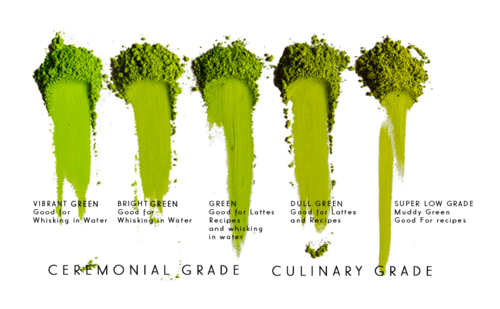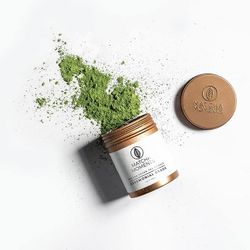Matcha
See also :
A green tea known as matcha—a finely milled, emerald green variety from Japan—has long been claimed to have greater health benefits than other green teas. Finally, a study from the University of Colorado validates these claims and explains them as being due to matcha's exceptionally high concentration of EGCG. The study's authors wrote: Results indicate that the concentration of [EGCG] available from drinking matcha is 137 times greater than the amount of EGCG available from China Green Tips green tea, and at least 3 times higher than the largest literature value for other green teas. The reason matcha provides such a concentrated dose of EGCG is that when you drink matcha, you are consuming the entire tea leaf. Matcha is made from only the very youngest, greenest, and finest leaves at the tip of the tea plant. These leaves are then dried and pulverized using stone grinders until the powder is extremely fine (approximately 9 microns). The Tea of Choice Among Japan's Royalty and Zen Buddhist Monks Historically, brilliant green matcha has been valued almost as highly as if it were, quite literally, ground from emeralds. For centuries, matcha was reserved exclusively for Japan's royalty and religious elite. Matcha has the unique ability to sustain mental alertness, increase alpha wave generation in the brain, and calm the central nervous system—all at the same time. This makes matcha an ideal drink to facilitate meditation. For that reason, matcha has been used by Zen Buddhist monks for almost 1,000 years. Matcha's lofty lineage kept prices prohibitively expensive for the North American market until only recently. Thanks to improvements in manufacturing efficiency, the cost has dropped enough to make matcha affordable for most people. Make Your Own Matcha As noted, matcha is remarkably potent, and every person's unique biochemistry will respond to it differently. In Japan, the average rate of consumption is 1-2 cups a day. Many prefer to drink a cup in the morning to prepare for the day, and a cup in the afternoon as a pick-me-up. Experts say there's no level at which matcha becomes toxic or dangerous.
Contents
Matcha Grades
There are two main types of Matcha—“ceremonial grade” and “ingredient grade.” Ceremonial grade Matcha is meant for mixing with water only, and should have a smooth finish with little to no bitterness. Cooking or mixing this grade with anything else would just mask the mild flavor. On the other hand, ingredient grade Matcha has a more bitter, astringent flavor that is great for mixing with other ingredients (like milk, sugar, flour, etc). Ceremonial grade matcha reportedly has a creamy, sweet taste compared to the food grade matcha, which has a bitter taste.
- Good quality Matcha is vibrantly green in color—often described as jade green—and lower qualities tend to have a more yellowish/brownish hue.
- A high quality Matcha should smell sweet and vegetal, thanks to the L-theanine amino acid that is preserved in the shade. Open air grown teas lose their amino acids because they are converted to catechins when exposed to the sun.
- The same amino acids that give Matcha its sweet smell should actually make the tea taste slightly sweet, too. When grown properly, a ceremonial grade Matcha shouldn’t be bitter. Ingredient grade Matcha should be slightly bitter, but not too much.
- You might not think to feel your Matcha, but it’s actually a great indicator of quality. A high quality Matcha should feel very fine and silky—similar to the feel of eye shadow or baby powder. The particle size is only around 5-10 microns, which is actually even finer than baby powder! Lower quality Matcha will have larger particle sizes that feel coarse between the fingers.
- When you vigorously whisk a good quality ceremonial Matcha with a bamboo whisk, it shouldn’t be too hard to create a layer of foam on top. No matter how hard you try, whisking a lower quality Matcha will often just result in large air bubbles (and frustration). Making drinks or baking with your ingredient grade Matcha should result in a deep green hue, and a pleasantly mild tea flavor. The taste shouldn’t be too bitter or too mild, but should perfectly compliment the other ingredients.
Special Precautions of Matcha
- See also precautions : Green Tea
- Matcha green tea is higher in EGCG than ordinary green tea so avoid taking very large amounts of the powdered form as this may pose a risk to liver damage.
- Although matcha is generally considered safe, the National Institutes of Health warn that green tea may cause stomach upset and constipation in some cases.
- Additionally, the NIH cautions against consuming more than five cups of green tea daily. Due to the caffeine content, excessive consumption of matcha or other forms of green may trigger certain side effects (such as headache, insomnia, irritability, diarrhea, and heartburn).
The benefits of Matcha are
Some proponents claim that matcha contains more antioxidants than other forms of green tea. In addition, matcha is purported to promote weight loss, lower cholesterol levels and blood pressure, support detox efforts, enhance mood, reduce stress, increase energy, keep blood sugar in check, and stimulate the immune system. Although there is a great deal of scientific evidence for the health benefits of green tea, very few studies have specifically focused on matcha.
- The available research on matcha includes a preliminary study published in the Journal of Medicinal Food in 2009. In tests on rats with type 2 diabetes, researchers found that treating the animals with matcha led to decreased levels of cholesterol, blood sugar, and harmful blood fats. What's more, matcha appeared to protect the rats from liver and kidney damage. According to the study's authors, matcha may contain higher amounts of epigallocatechin 3-O-gallate (a potent antioxidant) than other forms of green tea.
- anti-inflammatory : The catechins and L-theanines in Matcha have an anti-viral effect in flu. The EGCGs have an anti-bacterial effect on different sickness-causing micro-bodies, including Candidias Albicans. Matcha inhibits the growth of parasites. It curbs infections, clears up free radicals, reduces oxidative damage and protects the kidneys.
- While research on the specific health benefits of matcha is currently lacking, some studies suggest that regular consumption of green tea may offer a wide range of health benefits. For instance, green tea appears to prevent age-related cognitive impairment, reduce risk of stroke and diabetes, keep blood pressure in check, and strengthen bones.
- There's some evidence that green tea may help prevent several forms of cancer, including prostate cancer, lung cancer, pancreatic cancer, and colorectal cancer.


